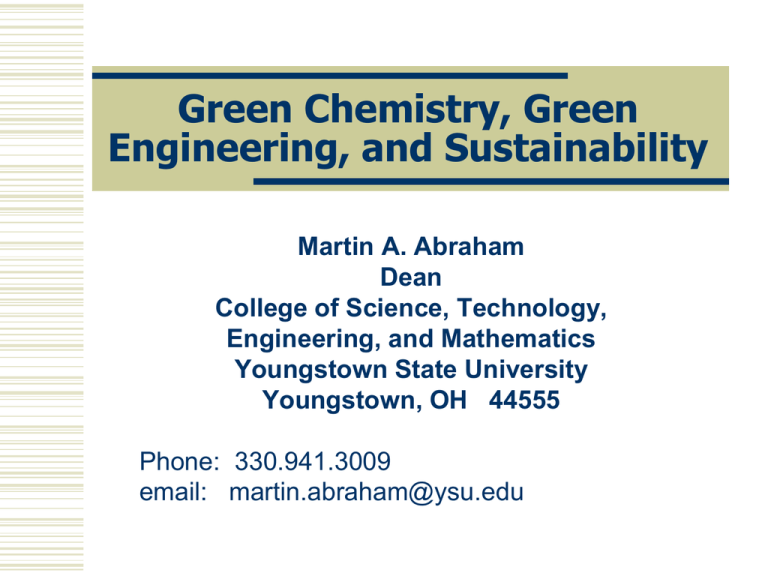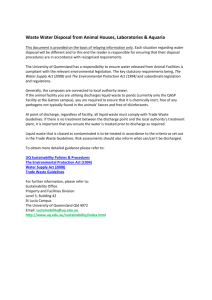engineer - Wayne State University
advertisement

Green Chemistry, Green Engineering, and Sustainability Martin A. Abraham Dean College of Science, Technology, Engineering, and Mathematics Youngstown State University Youngstown, OH 44555 Phone: 330.941.3009 email: martin.abraham@ysu.edu Engineers create goods for society An engineer is a person whose job is to design or build Raw materials Energy Machines Engines or electrical equipment, Roads, railways or bridges, Gasoline and other fuels Plastics using scientific principles. Wastewater Air pollutants Household products The manufacture of products that society desires is accompanied by the production of wastes, some of which cannot be avoided. 2 Engineering has lead to substantial productivity growth Affluence (3% income growth for last 100 years = Factor 20!) Leisure - Factor 4: Doubled life expectancy with half the working time Unprecedented quality and variety of products Unprecedented material use Unprecedented environmental impacts Global Change Paradox 1:We need green engineers to solve the problems created by the success of engineering Arnulf Grubler; ECI Green Engineering Conference, Sandestin, FL, May 2003 3 Sustainability, Green Engineering & Green Chemistry Sustainability Sustainability Green Engineering Green Engineering Green Chemistry Ecosystems Human Heath Lifecycle Systems Metrics Green Chemistry Reactions, catalysts Solvents Thermodynamics Toxicology 4 Green Engineering (EPA Definition) Source reduction Reuse or recycle The design, commercialization and use of processes & products that are feasible & economical while minimizing: Energy recovery Waste treatment Secure disposal Generation of pollution at the source Risk to human health & the environment Decisions to protect human health and the environment have the greatest impact and cost effectiveness when applied early to the design and development phase. 5 Green Engineering … develops and implements technologically and economically viable products, processes, and systems. transforms existing engineering disciplines and practices to those that promote sustainability. incorporates environmental issues as a criterion in engineering solutions promote human welfare protect human health protection of the biosphere. From the SanDestin Conference on Green Engineering: Defining the Principles. 6 Sustainability is … "..development that meets the needs of the present without compromising the ability of future generations to meet their own needs" World Commission on the Environment and Development A view of community that shows the links among its three parts: the economic part, the social part and the environmental part. 7 SanDestin Principles on Sustainable Engineering 1. 2. 3. 4. 5. 6. 7. 8. 9. Engineer processes and products holistically, use systems analysis, and integrate environmental impact assessment tools. Conserve and improve natural ecosystems while protecting human health and well-being. Use life cycle thinking in all engineering activities. Ensure that all material and energy inputs and outputs are as inherently safe and benign as possible. Minimize depletion of natural resources. Strive to prevent waste. Develop and apply engineering solutions, while being cognizant of local geography, aspirations and cultures. Create engineering solutions beyond current or dominant technologies; improve, innovate and invent (technologies) to achieve sustainability. Actively engage communities and stakeholders in development of engineering solutions. From the SanDestin Conference on Green Engineering: Defining the Principles. 8 Sustainability is a systems problem 9 Consider the Total Life Cycle Extraction of Raw Materials Processes Products Recycling Disposal Use of products 10 Risk Assessment Risk Hazard Exposure Risk is the probability of suffering harm or loss Risk assessment can be applied to processes and products: Data Collection and Evaluation Hazard Assessment Exposure Assessment Risk Characterization Planning Identification Reporting Assessment Response estimate the environmental impacts of specific chemicals on people and ecosystems; prioritize chemicals that need to be minimized or eliminated. optimize design to avoid or reduce environmental impacts; assess feed and recycle streams based on risk and not volume. 11 Metrics – What can be measured Mass utilization Material intensity (Mass in product/Mass in raw materials) Atom economy Potential environmental impact Energy utilization Energy intensity (per amount of product) Materials consumed to produce required energy Sustainability metrics Eco-efficiency (Economic indicator/Environmental indicator) Ecological footprint 12 Sustainability Metrics: Calculations Materials Pollutant Dispersion Mass of raw material Mass of Product Output Total mass of pollutants released Output Water Consumption Toxics Dispersion Volume of fresh wate r used Output Total mass of recognized toxics released Output Energy Land Use Net energy used Output Land covered, paved, or in buildings Output Output: Mass of Product or Sales Revenue or Value-added Dimensions of Sustainability The Sustainability Framework Lenses Resources Values Place Time Environmental Economic Societal Supply Production Use Fate Life Cycle Stages Adapted from BRIDGES to Sustainability, courtesy of Earl Beaver Development of Ecological Value Parameters considered •Raw Materials Ecological footprint Energy Consumption 1.00 •Energy consumption Land Use •Land Use 0.50 •Emissions 0.00 •Toxicity •Risk potential Raw Materials Emissions Ecological advantage Relative environmental impact High Product 2 BASF Toxicity Potential Product 1 Risk Potential Low 15 Sustainability Considerations Internal process, value-chain partnership, stakeholder engagement Resource Use Energy use, material intensity, water use, land use Econ. Social Business Perspective Management Environmental SD alignment with biz strategy & core value, core competencies, market & regulatory drivers Business Strategy Environmental Impact GHG emissions, air emissions, solid waste, (pollutant effects) Health & Safety Toxic reduction, hazards, process safety Societal Impact Workers’ well-being, local community impacts/QOL, global societal impacts/contributions Economic Impact Financials along value-chain (corporate, customers, …) AIChE Sustainability Index for the Chemical Industry The AIChE Sustainability Strategic Commitment Index will serve as the Environmental Performance premier technically Safety Performance informed benchmark for companies to measure their progress implementing sustainability. Social Responsibility The index is generated Product Stewardship from publicly available data and the results will be subject to public scrutiny. Value Chain Management 7 6 5 4 3 2 1 0 Sustainability Innovation Net Revenue > $10 Billion USD Net Revenue < $10 Billion USD Types of Costs Examples 1 - Direct Capital, labor, raw materials and waste disposal Operating and maintenance for treatment works 2 - Indirect Overhead costs not properly allocated to product or process Community relations Regulatory costs Monitoring costs 3 - Future & contingent Unforeseen, but very real costs liability Current Description Remediation, fines, restoration & penalties 4 - Internal intangible Image and relationship costs corporate costs Employee turnover Recruitment costs 5 - External intangible Public costs not yet borne internally Consumer perception Resource depletion Future More Difficult to Measure Cost Type Types of Benefits Examples 1 - Direct Selling price, fewer strikes and waste disposal choices Negotiating costs 2 - Indirect Overhead cost data for man ag e me n t Reduced Legal Costs 3 - Future & contingent Ease of permits liability Lower remediation, fines, penalties 4 - Internal intangible Employee benefits Employee health, productivity costs 5 - External intangible Public perception of employee attitude Lower public relations costs Current Description Future More Difficult to Measure Benefit Type Sustainable Energy?? Twentieth century humans used 10 times more energy than their ancestors had in the 1000 years preceding 1900 71 % increase by 2030 World Energy Consumption Distribution 80 % Fossil fuel 14 % Renewable (solar, wind, biomass, etc) 6 % Nuclear http://www.elmia.se/worldbioenergy/pdf/Mr%20Nystrom%20presentation.pdf 3/22/2016 1 GtC per yr avoided (3.7 GtCO2 per yr) Stabilization Wedges 1 wedge = 25 billion tons C (GtC) avoided (91.7 GtCO2) 50 years 2006 Wedges 2056 Global scope 50-year time horizon Simple shapes (e.g. triangles) Existing technologies with large potential (1 billion tons carbon per year after 50 years) Goal of level emissions, followed by decrease Source: Pacala and Socolow (Science 305, 968-972, 2004) 21 Solid-State Lighting… An example of environmental benefits Light Source Luminous Efficacy (Lumen/Watt) Lifetime (hr) Incandescent bulb 16 1000 Fluorescent lamp 85 10,000 Today’s white LEDs 30 20,000 Future white LEDs 150-200 100,000 Brighter, cheaper, more efficient Doubling the average luminous efficacy of white lighting through the use of solid-state lighting would potentially: • Decrease by 50% the global amount of electricity used for lighting. • Decrease by 10% the total global consumption of electricity (projected to be about 1.8 TW-hr/year, or $120B/year, by the year 2025). • Free over 250 GW of electric generating capacity for other uses, saving about $100B in construction costs. • Reduce projected 2025 global carbon emissions by about 300 Mtons/year. Renewable resources Widely available resources Bioproducts (e.g. sugar, corn) Inedible biomass Waste products, such as cheese whey Municipal waste CO2 Chemical Industry Opportunities include: Chemicals production Bio-composites Energy (e.g. methanol, biodiesel, H2) Biorefinery Consumer Biomass carbohydrates 23 Understanding the energy impact of biomass conversion 24 Moving towards sustainability 26









